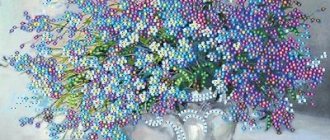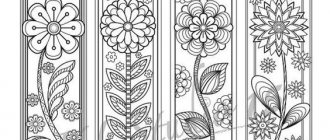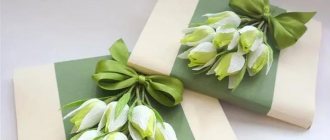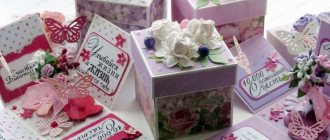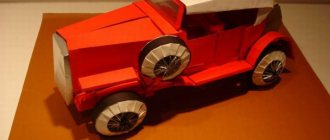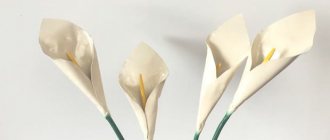DIY paper poppy
Do you have red paper, do you like to make paper flowers and are faced with the choice of how to make a beautiful but not complicated craft? The choice is obvious, make your own paper poppies . Firstly, it is really easy, the poppy is a very simple flower in structure. Secondly, it’s beautiful, and thirdly, why not, a good way to break away from the computer, TV and all electronic devices.
Here you will find 15 examples of how to make paper poppies in different versions. Using templates, master classes on poppies made from corrugated paper , napkins, colored paper and various scrap materials. This is a simple craft, get the kids involved, make a family day of paper flowers.
Required materials and tools
To get started, you should prepare all the necessary materials in advance. For a colored paper poppy you need:
- double-sided colored or corrugated paper (red, green, black) and a sheet of white;
- padding polyester or foam rubber (for decorating the middle, but not necessary);
- cardboard (if the option with gluing on it is chosen);
- glue, tape, tape;
- scissors, pencil (for tracing templates or drawing your own version);
- wire.
You can make poppies from corrugated paper with your own hands in the form of an applique, then you will also need felt-tip pens, pens, frames (for decoration), and for life-size flowers a special frame - a stand (for installation). The finished craft can be lightly sprayed with hairspray with glitter, which will imitate dew drops.
Volumetric bud
- Fold a double square from a sheet of the chosen color.
- Direct the side corners towards the center.
- Rearrange two sectors of the resulting figure.
- Bend the bottom corners towards the center.
- Point part of the top down.
- Rearrange the sectors and repeat.
- Open the bud and curl the petals.
We haven't mentioned the stems. Without them, the composition will not be complete.
For bouquets, use stems made from folded green paper in several layers. A good option is winding floral wire, especially for bulky items.
We'll talk about how to turn green paper into beautiful leaves for flowers next time.
You might be interested in learning how to do:
Origami boat
Paper butterfly
How to make poppies from paper and cardboard
High-quality assembly of poppies from paper and cardboard can be quickly done after viewing the diagram and video. For this:
- Templates of petals of different sizes are prepared from cardboard - 3 pcs.
- Petals are cut out of colored paper (scarlet) according to patterns - 9 large, 6 medium and 5 small.
- Cuts are made in the middle of the lower part of the petals.
- The places of the cuts are glued together with an overlap at each petal.
- A round base with a diameter of 10-12 cm is cut out of cardboard.
- The petals are glued along the very edge, starting with the largest ones, and overlapping.
- Each next row will come closer to the center - the small petals are glued last.
- A core is made from a circle of black paper - its edges are cut in the form of a fringe, which is slightly bent upward using scissors.
- The stamens are made from thin strips and ovals of black paper, glued together and fixed to the black core. Another smaller black circle is glued on top.
- The finished core is glued to the center of the flower.
This option looks very impressive when decorating walls, furniture, and festive tables.
Step-by-step instructions for flowers
The classic arrangement of poppy flowers with stems and leaves is slightly different. The work is carried out step by step:
- a small piece of padding polyester is attached to the wire with glue or thread, giving it a rounded shape;
- wrap it with a piece of green corrugated paper, give it a “box” shape by twisting it with threads in the center, dividing it into sectors;
- a fringe is cut from a piece of black paper and glued to the bottom of the base;
- 8-9 petals are cut out of red paper according to the pattern, their edges are stretched and given the desired bend;
- glue two petals opposite each other, then others in the same sequence;
- leaves are cut out of green paper - smaller in shape (fixed to the petals on the underside) and curly, placing them on a wire-stem;
- tape is applied to the entire stem.
The flower elements are given a natural shape.
To make poppies look more natural, each petal should be slightly stretched and given the desired shape before gluing it to the base.
Step-by-step assembly of a bouquet with poppies
After studying the master class on assembling one flower, you can make a whole bouquet. Using a cutting template will make the job easy and quick.
Ready-made poppies are combined into a bouquet, where you can add decor and beads on a fishing line. Everything is decorated with a beautiful satin ribbon or lace.
Origami with diagram
When making crafts using the modular origami technique, the following assembly steps are performed:
- A sheet of colored paper in A4 format is folded in half twice and cut into 4 even squares;
- the resulting square is folded diagonally onto the corner, the excess is cut off;
- bend two sides of the square towards the center;
- the acute angle is bent towards the middle, the module is ready;
- for poppy seeds, you should make 7-8 modules and fasten them together by inserting inserts into the pockets of the blanks;
- fix the joints with glue;
- the edges of the finished petals are worked with scissors so that they receive a natural bend;
- glue a black circle into the middle of the poppy, or paint it, or glue a ball of black corrugated paper;
- flower leaves - a rectangular piece of green paper is folded in half, and the leaf is cut into any shape.
All elements are attached to the stem wire, secured with glue, tape or tape. Several poppies made will make a beautiful bouquet for a vase. Using this technique you can also make a panel on the wall. To do this, trunks and foliage made of green paper are glued to the base, and the finished flowers are fixed last. Origami poppy panels are decorated with a frame.
When folding the sides in origami, it is fundamentally necessary to iron each fold so that the fold is sharp. Thanks to this, the product will be smooth and neat.
Applications for children
Even the smallest children can make beautiful poppy flowers in the form of an applique:
- on a sheet of colored paper (red) I draw a circle with a black felt-tip pen or paint (with a diameter close to the size of the flower);
- a black core with stamens is drawn in a circle;
- make several of these blanks of different sizes and cut them out;
- each piece is folded in the middle and in half two more times, imitating poppy petals;
- straighten the future flower, leaving bends;
- poppies are glued on green cardboard in a chaotic manner;
- Use a dark felt-tip pen or paint to draw stems, leaves and poppy boxes.
The buds are completed or glued, cut out (in the form of ovals) from green paper.
The applique will look complete if its edges are decorated with frames or covered with contrasting colored paper.
Volume craft
There is no difference in how to make large poppies from paper compared to flowers of regular sizes. A more voluminous look is given to flowers by choosing large patterns and a large number of petals. Volumetric crafts bring an element of solemnity into the space; they are placed on furniture, tables, walls, stairs, and hung on ribbons from the ceiling. A large poppy made of corrugated paper is complemented by a core, which can be made in different ways (in the form of a green box, just black, with various stamens).
Full size flowers
Growing poppies made of corrugated paper are currently very popular. They are assembled according to the classic version described above. In addition to the growing poppy, you need to purchase a stand and a stick, which will be the basis for assembling the flower. Its size should fit the diameter of the stand (for connection). A large paper poppy will decorate the interior not only in the house, but also in any office, foyer of organizations and institutions, cinemas, clubs, kindergartens and schools, fitness centers.
https://youtu.be/MUdGePfsIaE
Origami "Chamomile"
The secret of a beautiful origami paper daisy is a large number of petals, which you need to fold separately. Then use the flower as an applique or stick it on a thick base to add volume and assemble a bouquet. Fold the white diamond into a triangle with the base facing up and fold its sides up from the top. Turn the protruding corners to the joint in the opposite direction and turn the part over - this is one petal.
Using the same principle, only using green paper, fold the leaves. Place the square with the angle up and fold its side back and forth so that the fold goes in the middle of the rhombus and the edges coincide. Do the same on the other side - and the leaf is ready!
DIY fabric poppies: master class on making hairpins
You can try making this accessory using sophisticated technology. A wire frame will be used for each element, and the middle will be created separately on your own. The sequence of work is as follows:
- As in the previous method, take synthetic fabric, cut out the petals and process over a candle flame.
- Cut the wire into elements according to the number of parts of the flower (petals, center, stamens) with a length equal to at least the petal, but preferably longer to make it easier to work with. If you are going to create a flower on a stem, take the maximum height taking into account the stem (measure the depth of the vase).
- Apply glue to each piece of wire and wrap it in strips (no more than 5 mm) of corrugated paper. It is better to take it to match the elements or white.
- Attach the resulting frame elements to the petals using glue (this is faster) or threads (more neat) to match the fabric.
- Make the stamens as in the previous method, only use a wire blank to pull the bundle of threads.
- Take a circle of green fabric, sew it around the perimeter and pull it into a bag. Fill it with cotton wool, padding polyester or whatever you have. Secure with thread. Wrap it with a piece of wire to form a box. Instead of a circle of green fabric, use a ball of green wool for felting.
- Connect all the parts with glue into a single whole, forming a stem, or cutting off excess pieces of the frame.
- You can make several flowers of different sizes or shades and glue the floral arrangement to the base (clip).
The work is completed. This is how you can make fabric poppies with your own hands in different ways. The master class, detailed description of actions and materials will help you implement any option easily.
Origami “Violet”
Cut out a small pentagon from a sheet of paper and mark all its centers and diagonals, as in the diagram. Assemble a diamond-shaped multi-layered petal so that there is one inner bend on the left and two on the right. On the right, bend the edge about a centimeter through all the layers at once, turn the parts over and do the same on the left.
Firmly grasp the base of the origami flower and turn all the petals down, and then gently twist the same base to give shape. For greater expressiveness, use a thin toothpick to carefully bend all the inner and outer corners of the petals. This way the flower will become more elegant and at the same time more textured!
Cutting out flower details
Print out the petals and sepals pattern template.
Trace 4 small petals and 4 large ones onto thin fabric. You need to cut out the petals obliquely, at an angle of 45 degrees to the grain thread.
All pencil tracing should remain outside after cutting. The correct petal should be neat and clean.
History of Origami
Origami appeared many centuries ago. The history of Origami is closely connected with the advent of paper in 105 AD. on the territory of Ancient China.
The Chinese kept the creation of paper a terrible secret, but the wandering monk Dan-Ho, who went to Japan, managed to loosen his tongue and report on the secret and method of making paper using Chinese technologies.
Japan immediately picked up the idea, and paper production began on its territory. Perhaps that is why Japan was called the birthplace of Origami.
Japanese monks began to fold various paper figures. At the same time, origami began to be called “origami” = “folded paper” (“ori” - folding + “gami” - paper).
The Japanese began to bring the first crafts as donations to the temple. Origami figures began to decorate temple walls and courtyards.
The more paper production developed, the more the nobles and other representatives of the upper classes became interested in folding paper figures.
Paper was very expensive back then, so only noble people and monks who made figures for donations were involved in folding origami.
Experimenting with folds in different directions, Origami lovers created more and more new figures. Origami has grown into a whole art of folding.
Origami officially got its name in 1880. And in the middle of the 20th century, Akiro Yoshizawa published “The ABC of Origami”; from that time on, fascinating paper folding began to gain popularity among children and adults.
By quickly folding paper and getting amazingly beautiful shapes, no one remains indifferent to their paper creation.
Nowadays, paper is not as valuable a material as it was in ancient times, so anyone can take up folding.
Processing patterns for poppy seeds from foamiran
To make poppy petals and leaves look more realistic, you need to process them in a special way. Each pattern is colored and designed separately.
If you don't have a special mold, you can make it yourself by wrapping it in corrugated paper in a tablespoon.
In addition to foamiran blanks, you will need a small piece of green polymer clay, pastel paints, glue, varnish, a feminine sanitary pad, a black, dark gray and dark blue spool of thread, semolina.
Often, black, red and green materials are used to make foam poppies.
Master class on pattern processing with step-by-step description:
- The middle of the lower part of each petal is painted with dry black pastel. At the same time, the “bed” pencil should be moved along the foamiran lightly enough so that the red color can be seen through the black layer.
- Now we apply the petal to the iron for a few seconds and press it into the mold to form the bend and relief we need.
- After the patterns have cooled, heat them on a curling iron, curl them, and then straighten them. To make the edges of the poppy petals more prominent, you need to apply them to the curling iron for literally one or two seconds, and then stretch them with your fingers.
- Poppy leaves have a slight whitish coating. To achieve this effect, you need to coat each leaf and sepal on one side with varnish and apply it to the cut gasket. Excess pieces of cotton wool must be removed using tweezers.
- From a piece of green polymer clay, you need to make a box. A poppy boll is a ball with voluminous veins in the center, into which you need to stick a wire the length of a poppy stem. After baking, it needs to be coated with acrylic varnish.
- To make poppy stamens, wrap three colors of thread at the same time on a piece of cardboard 3 cm wide, cut them from the left and right edges, and tie the thread in the center. Make three such bundles. Distribute the threads evenly around the box and cut off any strongly protruding threads. You should have a circle of thread around the base. Dip the edges of the threads into PVA glue and then into semolina.
All these elements are needed for one flower with a bud; if you want to make a rim, then you need to make at least three times as many blanks.
Origami “Violet”
Cut out a small pentagon from a sheet of paper and mark all its centers and diagonals, as in the diagram. Assemble a diamond-shaped multi-layered petal so that there is one inner bend on the left and two on the right. On the right, bend the edge about a centimeter through all the layers at once, turn the parts over and do the same on the left. Firmly grasp the base of the origami flower and turn all the petals down, and then gently twist the same base to give shape. For greater expressiveness, use a thin toothpick to carefully bend all the inner and outer corners of the petals. This way the flower will become more elegant and at the same time more textured!
Simple but interesting petal shaping
Here I will show you how to shape the petals, giving them the shape of a real, living flower. It seems to me that this flower also looks like an aster.
Cut the roll in half widthwise.
Cut 20 cm. Fold in half 3 times to get 8 peony petals. Cut off the corners on top.
We cut the rectangles along the fold lines, but do not cut the paper completely, leaving 2-3 cm to the edge.
Without unfolding, we twist the paper (like we twist linen). One way and then the other.
Unfold once and scroll 4 more petals together.
Unfold and stretch the middle of each petal.
We glue 2 such strips to each other in a checkerboard pattern. It is necessary that the petals of one strip are located between the petals of the second strip.
And such blanks can already be twisted to make peonies.
More details on the author's video:
And the same method, but different design.
More options you can try to make. The first of them is according to the method described in this section. But here it’s a little more fluffy and we’ve chosen light and dark pink for the middle.
In the next photo, the lower aster contains petals of different lengths and due to this, a completely different interesting look is obtained.
Author
Aster
In this master class we will look at how to make flowers with very thin petals, for example, like those of an aster.
We will need:
- Lilac paper: 5 pcs. – 16 cm by 1 m, 3 pcs. – 20 cm by 1 m, 5 pcs. – 24 cm by 1 m.
- Pink: 10 cm by 1 m.
- Pliers;
- Wire;
- Glue gun;
- Scissors.
Making:
We bend a strip of 16x100 cm in half. We cut off the edge with sharp teeth.
Glue the wire inside along the fold line. And slightly gather the paper into a small fold.
We do everything exactly the same with strips 20 and 24 cm wide.
We cut the pink paper into strips (fringed), without cutting to the edge, and roll it into a roll.
We begin to assemble the structure from the middle. We twist the pink blank.
Glue this blank to the edge of lilac paper (16 cm wide).
Twist and glue the pink lilac blank around it. And so all 5 parts.
Then we twist the workpiece larger (3 parts).
And at the end we twist a large blank (5 parts), the width of which is 24 cm. Be sure to glue the base of the flower for better fixation.
Decorate the bottom with paper.
Where is such beauty? You can decorate a room for a holiday or a studio for a photo shoot. Due to double fixation: wire and glue, the flowers will retain their shape and attractive appearance for a long time.
Author MK
